
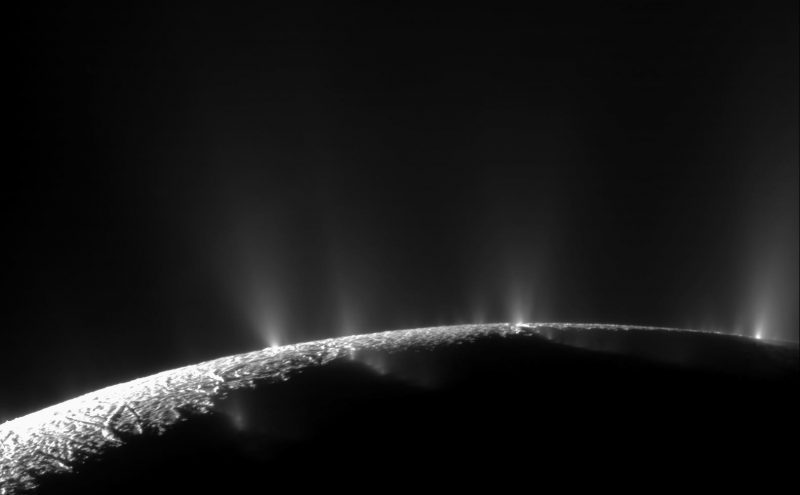
The geysers of Saturn’s moon Enceladus. These great plumes of water vapor erupt through fractures in the ice crust at this moon’s south pole. The Cassini spacecraft analyzed the plumes and found water vapor, ice particles, salts, methane and a variety of complex and simple organic molecules. Scientists think they originate from the ocean below the moon’s icy surface. Image via NASA/JPL-Caltech/Space Science Institute.
Is the subsurface ocean on Saturn’s moon Enceladus habitable? Could it be home to existing life forms? While we still don’t know the answer to the second question, evidence continues to build that this small moon’s ocean is habitable by earthly standards. On October 2, 2019, scientists announced another piece of the puzzle: the discovery of additional kinds of organic compounds that originate from Enceladus’ ocean, and were found by the Cassini spacecraft to be gushing out through geysers at the moon’s south pole. These compounds are the ingredients for amino acids, the building blocks of life on Earth.
The intriguing new peer-reviewed findings were published October 2, 2019 in the Monthly Notices of the Royal Astronomical Society.
The findings come from continued analysis of data from the Cassini mission at Saturn, which ended in 2017. The spacecraft had sampled water vapor in the huge geyser-like plumes that erupt from fractures at the south pole of the moon called Tiger Stripes. The results showed water vapor, ice grains, salts, methane and organic molecules of various sizes existing in the plumes.
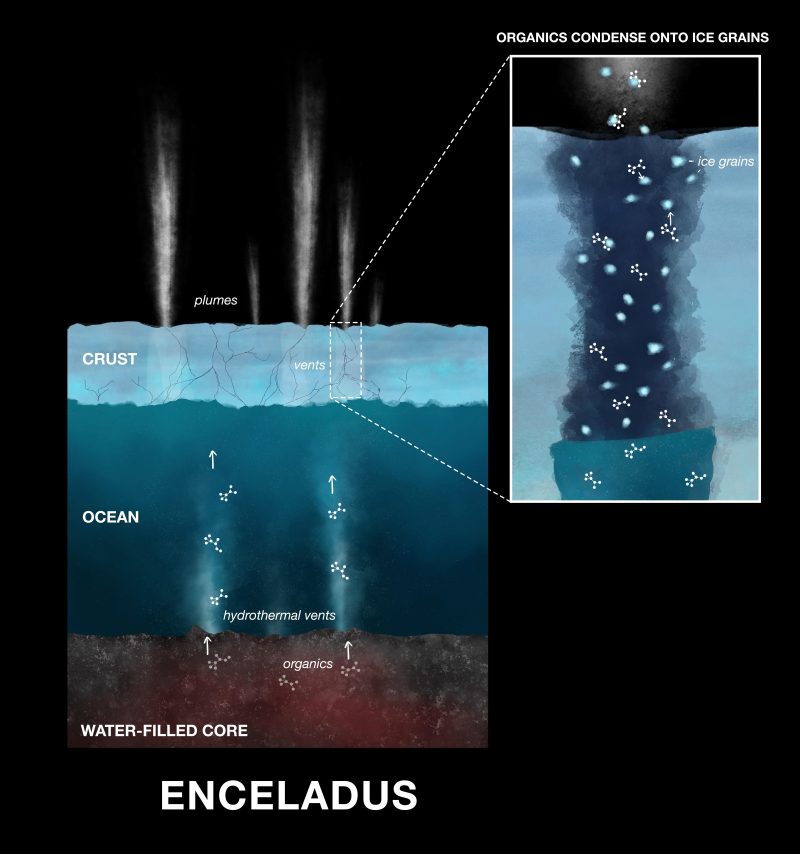
Illustration depicting how the organic compounds, originating from ocean bottom hydrothermal vents, are condensed onto ice grains in cracks in Enceladus’ crust. The ice grains and organics then get ejected into space by the water vapor plumes. Image via NASA/JPL-Caltech.
Cassini also found evidence for active hydrothermal vents on the ocean floor, similar to ones seen on the ocean bottoms of Earth. The new organic compounds were found to be nitrogen- and oxygen-bearing, condensed onto the ice grains. On Earth, those same compounds are produced by hydrothermal vents, and are part of the chemical reactions that produce amino acids. Is the same thing happening on Enceladus? As Nozair Khawaja, at the Free University of Berlin, explained:
If the conditions are right, these molecules coming from the deep ocean of Enceladus could be on the same reaction pathway as we see here on Earth. We don’t yet know if amino acids are needed for life beyond Earth, but finding the molecules that form amino acids is an important piece of the puzzle.
The ice grains from Enceladus’ plumes also get injected into Saturn’s E ring. The new compounds were found on these ice grains by Cassini’s Cosmic Dust Analyzer (CDA). The composition of the organic material was determined by the CDA’s mass spectrometer.
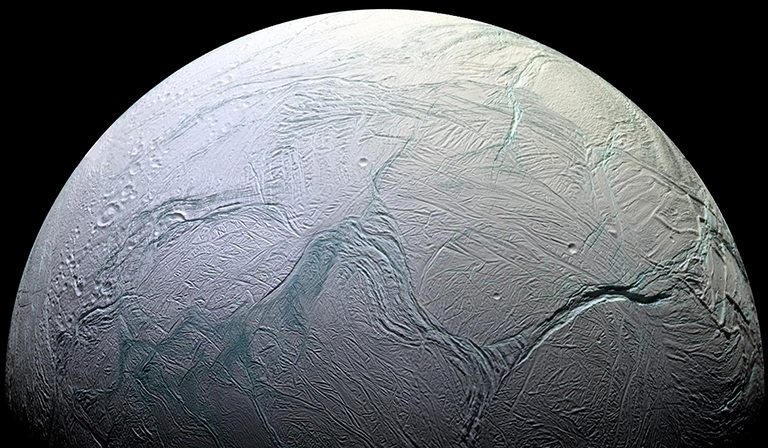
Enceladus as seen by the Cassini spacecraft. This small, icy moon has a global subsurface ocean that could possibly support life. Image via NASA/JPL-Caltech/NASA Science.
So how did these and other organics get into space? First, they were dissolved in the subsurface ocean itself. They were then evaporated out of the water, condensing and freezing onto ice grains inside the fractures in the moon’s crust. As the plumes of water vapor from the ocean move upward through the fractures to the surface, they transport the ice grains and organics with them. After being injected into space, these grains can then be sampled and analyzed by spacecraft such as Cassini.
Cassini had already found found larger organic molecules in the plumes. These new compounds however, although smaller, are tied directly to the hydrothermal processes that would create amino acids. According to co-author Jon Hillier:
Here we are finding smaller and soluble organic building blocks – potential precursors for amino acids and other ingredients required for life on Earth.
Another co-author, Frank Postberg, added:
This work shows that Enceladus’ ocean has reactive building blocks in abundance, and it’s another green light in the investigation of the habitability of Enceladus.
Another recent study showed that Enceladus’ ocean is also apparently just the right age to support life.
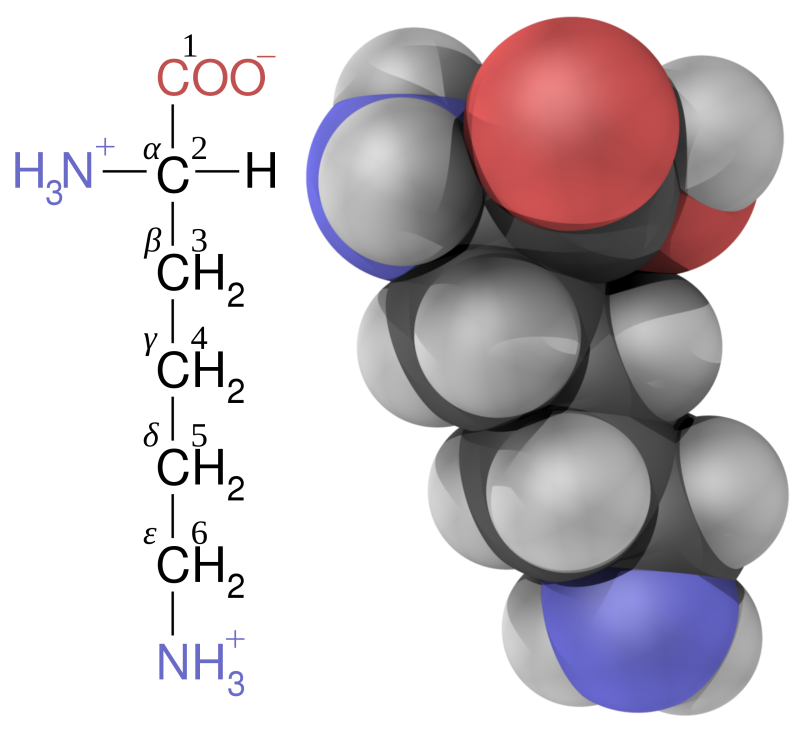
Diagram of the amino acid Lysine, which has carbon atoms attached and is used in the biosynthesis of proteins. Amino acids are the building blocks of life as we know it, and now they have been discovered in Enceladus’ plumes. Image via Wikipedia/CC BY 3.0.
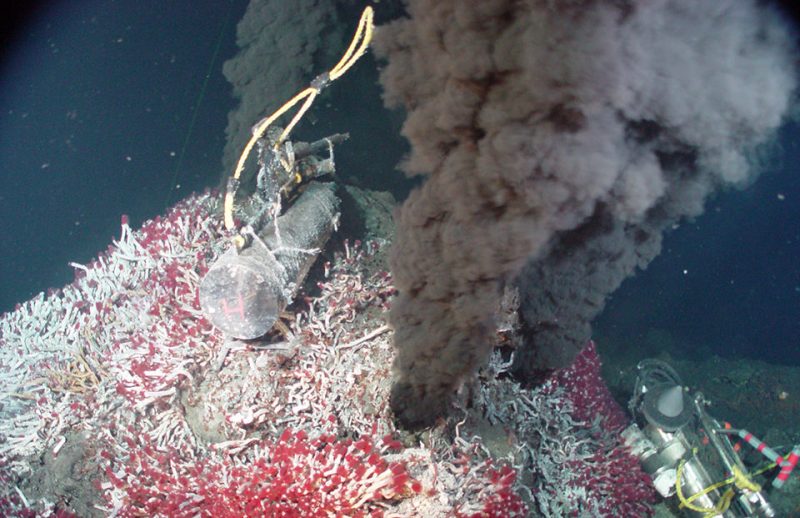
A “black smoker” hydrothermal vent on the ocean floor on Earth. Similar vents are thought to exist on the ocean floor of Enceladus as well, where the organic compounds most likely originate from. Image via National Ocean Service (NOA).
The discovery of these smaller – but vital – organic compounds is another significant piece of the puzzle in understanding Enceladus’ possible habitability. Although completely frozen on the outside surface, on the inside, Enceladus is a most remarkable little world. Beneath the outer ice crust lies a global warm salty ocean, that, it appears, is not too different from oceans on Earth. The rocky bottom, including the hydrothermal vents, provides chemical nutrients just as it does on our planet. The environment is similar to that around hydrothermal vents – or “smokers” – on Earth’s ocean bottoms. The vents provide heat and nutrients and at least on Earth, serve as an oasis for a multitude of life forms despite the surrounding colder waters and complete lack of sunlight.
These new findings make Enceladus and other ocean moons in the solar system, such as Europa and Titan, even more enticing targets in the search for life elsewhere in the solar system. Not that long ago, it was thought that Earth was the only world in our solar system with liquid water. Now we know of several moons in the outer solar system that do as well (and maybe even Pluto!), it’s just that the water is hidden below an outer layer of ice. We don’t know yet if any of those water worlds actually host any kind of life, but being able to study some of these alien oceans both now and with more advanced future missions is certainly one of the most exciting developments in planetary exploration.
Bottom line: Further analysis of material in Enceladus’ water vapor plumes has revealed the existence of additional organic compounds, the kind that are the ingredients of amino acids, the building blocks of life on Earth.
Source: Low-mass nitrogen-, oxygen-bearing, and aromatic compounds in Enceladean ice grains
from EarthSky https://ift.tt/30YXa1T


The geysers of Saturn’s moon Enceladus. These great plumes of water vapor erupt through fractures in the ice crust at this moon’s south pole. The Cassini spacecraft analyzed the plumes and found water vapor, ice particles, salts, methane and a variety of complex and simple organic molecules. Scientists think they originate from the ocean below the moon’s icy surface. Image via NASA/JPL-Caltech/Space Science Institute.
Is the subsurface ocean on Saturn’s moon Enceladus habitable? Could it be home to existing life forms? While we still don’t know the answer to the second question, evidence continues to build that this small moon’s ocean is habitable by earthly standards. On October 2, 2019, scientists announced another piece of the puzzle: the discovery of additional kinds of organic compounds that originate from Enceladus’ ocean, and were found by the Cassini spacecraft to be gushing out through geysers at the moon’s south pole. These compounds are the ingredients for amino acids, the building blocks of life on Earth.
The intriguing new peer-reviewed findings were published October 2, 2019 in the Monthly Notices of the Royal Astronomical Society.
The findings come from continued analysis of data from the Cassini mission at Saturn, which ended in 2017. The spacecraft had sampled water vapor in the huge geyser-like plumes that erupt from fractures at the south pole of the moon called Tiger Stripes. The results showed water vapor, ice grains, salts, methane and organic molecules of various sizes existing in the plumes.

Illustration depicting how the organic compounds, originating from ocean bottom hydrothermal vents, are condensed onto ice grains in cracks in Enceladus’ crust. The ice grains and organics then get ejected into space by the water vapor plumes. Image via NASA/JPL-Caltech.
Cassini also found evidence for active hydrothermal vents on the ocean floor, similar to ones seen on the ocean bottoms of Earth. The new organic compounds were found to be nitrogen- and oxygen-bearing, condensed onto the ice grains. On Earth, those same compounds are produced by hydrothermal vents, and are part of the chemical reactions that produce amino acids. Is the same thing happening on Enceladus? As Nozair Khawaja, at the Free University of Berlin, explained:
If the conditions are right, these molecules coming from the deep ocean of Enceladus could be on the same reaction pathway as we see here on Earth. We don’t yet know if amino acids are needed for life beyond Earth, but finding the molecules that form amino acids is an important piece of the puzzle.
The ice grains from Enceladus’ plumes also get injected into Saturn’s E ring. The new compounds were found on these ice grains by Cassini’s Cosmic Dust Analyzer (CDA). The composition of the organic material was determined by the CDA’s mass spectrometer.

Enceladus as seen by the Cassini spacecraft. This small, icy moon has a global subsurface ocean that could possibly support life. Image via NASA/JPL-Caltech/NASA Science.
So how did these and other organics get into space? First, they were dissolved in the subsurface ocean itself. They were then evaporated out of the water, condensing and freezing onto ice grains inside the fractures in the moon’s crust. As the plumes of water vapor from the ocean move upward through the fractures to the surface, they transport the ice grains and organics with them. After being injected into space, these grains can then be sampled and analyzed by spacecraft such as Cassini.
Cassini had already found found larger organic molecules in the plumes. These new compounds however, although smaller, are tied directly to the hydrothermal processes that would create amino acids. According to co-author Jon Hillier:
Here we are finding smaller and soluble organic building blocks – potential precursors for amino acids and other ingredients required for life on Earth.
Another co-author, Frank Postberg, added:
This work shows that Enceladus’ ocean has reactive building blocks in abundance, and it’s another green light in the investigation of the habitability of Enceladus.
Another recent study showed that Enceladus’ ocean is also apparently just the right age to support life.

Diagram of the amino acid Lysine, which has carbon atoms attached and is used in the biosynthesis of proteins. Amino acids are the building blocks of life as we know it, and now they have been discovered in Enceladus’ plumes. Image via Wikipedia/CC BY 3.0.

A “black smoker” hydrothermal vent on the ocean floor on Earth. Similar vents are thought to exist on the ocean floor of Enceladus as well, where the organic compounds most likely originate from. Image via National Ocean Service (NOA).
The discovery of these smaller – but vital – organic compounds is another significant piece of the puzzle in understanding Enceladus’ possible habitability. Although completely frozen on the outside surface, on the inside, Enceladus is a most remarkable little world. Beneath the outer ice crust lies a global warm salty ocean, that, it appears, is not too different from oceans on Earth. The rocky bottom, including the hydrothermal vents, provides chemical nutrients just as it does on our planet. The environment is similar to that around hydrothermal vents – or “smokers” – on Earth’s ocean bottoms. The vents provide heat and nutrients and at least on Earth, serve as an oasis for a multitude of life forms despite the surrounding colder waters and complete lack of sunlight.
These new findings make Enceladus and other ocean moons in the solar system, such as Europa and Titan, even more enticing targets in the search for life elsewhere in the solar system. Not that long ago, it was thought that Earth was the only world in our solar system with liquid water. Now we know of several moons in the outer solar system that do as well (and maybe even Pluto!), it’s just that the water is hidden below an outer layer of ice. We don’t know yet if any of those water worlds actually host any kind of life, but being able to study some of these alien oceans both now and with more advanced future missions is certainly one of the most exciting developments in planetary exploration.
Bottom line: Further analysis of material in Enceladus’ water vapor plumes has revealed the existence of additional organic compounds, the kind that are the ingredients of amino acids, the building blocks of life on Earth.
Source: Low-mass nitrogen-, oxygen-bearing, and aromatic compounds in Enceladean ice grains
from EarthSky https://ift.tt/30YXa1T

Aucun commentaire:
Enregistrer un commentaire